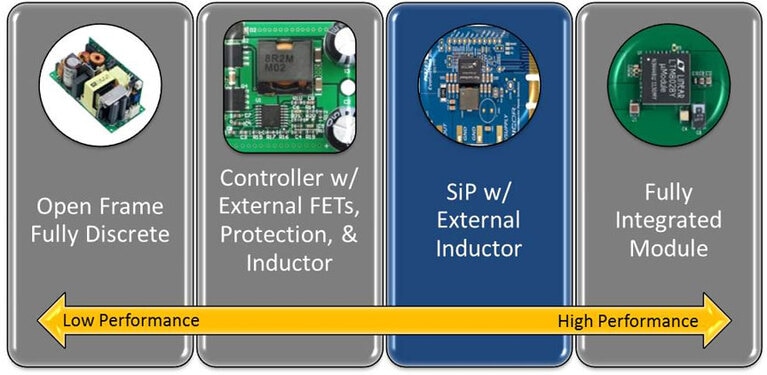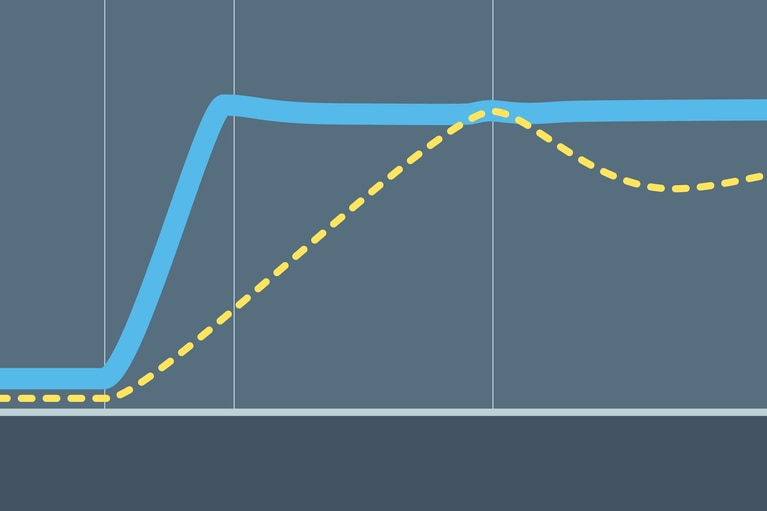
ReVolt – 技术问答
ReVolt 正在解决好莱坞片场的排放问题,下一步将把便携式 DC 电源应用于建筑工地、应急响应事件等领域
尊敬的用户:
为了改进 Vicor 网站,我们将于美国东部时间 12 月 29 日上午 11:30 至下午 2:00 对网站进行维护。
在此期间,您可能无法查看网站的某些部分,特别是产品页面和产品型号列表。
对于给您带来的不便,我们深表歉意,并感谢您的耐心等待。
– Vicor 网站团队
Switching regulator solutions are offered in various levels of integration, offering a broad spectrum of performance, features, and packaging. They range from open frame discrete solutions to fully integrated modules.
Figure 1. Different levels of Integration in Regulator Solutions
There are numerous tradeoffs to each type of design, but the one that takes the lead in performance vs. cost for the 50W to 100W-type point-of-load design is the SiP-type regulator, especially when combined with a ZVS switching topology. These SiP-based regulators, like our Vicor ZVS regulators, are built on an over-molded substrate, which integrates power FETs, passive components, and predefined compensation components. This packaging approach integrates the majority of the regulator system except for the inductor and input/output capacitors.
With an external inductor, board-level heat dissipation is superior vs. the module approach where heat is concentrated in one location (the inductor can generate 40-50% of the total regulator heat). Without being constrained by package profile limitations external inductor design can be optimized for efficiency. Lower switching losses of the Vicor ZVS topology translate into higher efficiency, lower heat dissipation, and higher density. On the cost side, competitive modules from various IC vendors, including Vicor, typically hold a 1.5x to 3x premium over SiP-based regulators.
Considering that module performance lags vs. SiPs, and they cost more, designers might ask if the modules’ small gains in density are really worth it. At least for the Vicor-based SiP regulators, our density (power delivery vs. x-y board area consumption) is on par with modules, even when including all the required components (the external inductor and input/output capacitors). This is because the modules also require external input/output capacitance. Vicor’s ZVS topology supports high frequency operation (without sacrificing efficiency) and this allows for smaller passives.
Applications vary and hence there is a need for various levels of regulator integration, however, when looking at efficiency, size, and cost, our ZVS regulators set a performance/cost metric that surpasses that of many fully integrated modules. This can be counter intuitive to many designers especially when not aware of the added benefits of a ZVS switching topology regulator.
Related content
Product overview: ZVS buck switching regulators
ReVolt – 技术问答
ReVolt 正在解决好莱坞片场的排放问题,下一步将把便携式 DC 电源应用于建筑工地、应急响应事件等领域
双向供电与快速瞬态响应能力赋能可扩展的主动悬架系统
正弦振幅转换器™(SAC™)模块凭借其独特的双向供电功能与瞬态响应速度组合,为主动悬架系统开辟了全新可能性
提供更高的峰值功率和更快的动态瞬态响应,实现更轻、更强大的电动汽车架构
随着时间的推移,市场上的电动汽车 (EV) 对电驱动系统的依赖程度日益加深,例如线控转向、线控制动以及主动悬架系统等
电流倍增器:为 AI 处理器及其他严苛应用供电的明智之选
AI 处理器需要解决低电压、高电流的严苛挑战,这将会导致电源系统设计产生瓶颈。了解 Vicor 的电流倍增技术如何改变这一现状



